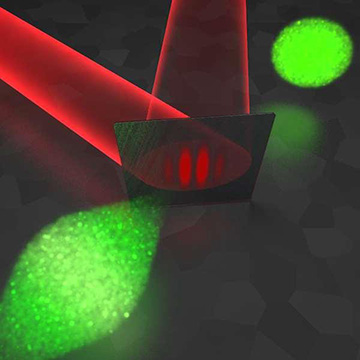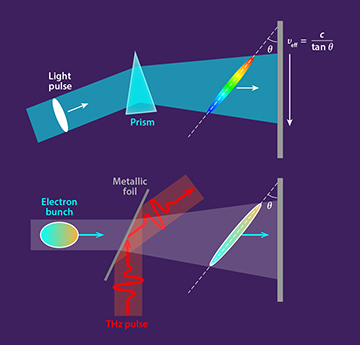
Recent experiments demonstrate how an electron bunch (green), through spatially varying momentum transfer from terahertz radiation (red), can be transformed into a tilted femtosecond electron pulse. [Image: © P. Baum]
Using a terahertz laser and a strategically placed piece of electron-transparent, light-reflective foil, a German research team has produced femtosecond pulses made of bunches of electrons—and with the pulse’s energy front “tilted” at an angle to the propagation direction (Phys. Rev. Lett., doi: 10.1103/PhysRevLett.121.094801). The experiments, say the team, show that “ultrashort electron pulses can be shaped in space and time as versatilely as femtosecond laser pulses”—but at a wavelength a hundred thousand times finer.
The resulting control and “sub-nanometer imaging resolution,” the researchers believe, could prove useful in pulse-probe experiments to dig into the details of ultrafast molecular dynamics, and could also improve the capabilities of free-electron lasers. And the team thinks the demo sets up a variety of opportunities for creating even more exotic electron beams and pulse shapes.
A question of dispersion
In the optical domain, the tricks for creating a tilted femtosecond pulse are well established: Pass the pulse through an element, such as a prism or a grating, that has a measure of angular dispersion cooked in. As every schoolchild knows, the action of the prism will deflect the different frequencies at different angles, resulting in the familiar spectrum. But it also, depending on the prism’s orientation, will tilt the pulse’s energy front, so that one side of the pulse travels ahead of the other side.
Doing the same thing, both in time and in space, is a lot trickier with electrons. Because they naturally tend to repel each other, it’s tough to make electrons hang together in a pulse compressed in time—let alone to dynamically shape the pulse in space.
A light pulse can be tilted and spread out via the angular dispersion introduced by a prism (top). The Baum team’s experiments use a piece of off-angle foil and a terahertz beam as an analogous dispersive element to create a tilted electron pulse (bottom). [Image: APS/Alan Stonebraker; used with permission of APS] [Enlarge image]
A “prism” for electrons
To bring a new level of control and compression to electron pulses, the research team, led by Peter Baum of the Universität Konstanz, Ludwig-Maximilians-Universität and Max Planck Institute for Quantum Optics, put a piece of tilted foil, combined with a terahertz laser, into service in the role the prism plays in the optical realm.
The Baum team’s setup, refined in a number of experiments in recent years (Science, doi: 10.1126/science.aae0003), begins with a laser pulse from a Yb:YAG amplifier, which is split into two beamlines. One beam is sent to a gold thin-film photocathode to create an ultrashort pulse of electrons; the other passes through a nonlinear crystal to create a terahertz pulse of light.
The two pulses, traveling perpendicular to one another, are aimed at a metal mirror that’s placed off-angle to both. The mirror is made of a metallic foil that reflects terahertz radiation, but that lets electrons pass through. That means that different zones of the electron bunch interact with the terahertz beam as it strikes and reflects off of the foil.
The system works through the transfer of momentum between the terahertz radiation’s electric field and the electron pulse. The momentum transfer from the horizontal component of the terahertz field (that is, the component in the direction of electron-pulse propagation) accelerates the back of the electron pulse and decelerates the front of the pulse, shortening the pulse width. The momentum transfer from the vertical component of the terahertz field (that is, the component normal to electron-pulse propagation direction), as it strikes and reflects off of the tilted foil, differentially deflects the top and bottom of the electron pulse.
Sublight speed, electron-microscope resolution
The output of the setup is an electron pulse that has a constant gradient in space—that is, a tilted pulse front—and that’s uniformly compressed in time. Additional experiments revealed that the pulse-front tilt correlates directly with the system’s angular dispersion. That means that the details of the pulse compression and tilt can be controlled by tweaking the angles that the foil makes with the terahertz and electron beams.
Moreover, the width of the electron pulses, which travel at sublight speed, is, according to the team, is on the order of 105 times finer than that of femtosecond laser pulses. That puts the electron pulses on a par with the imaging resolution of electron microscopy, as Baum noted in a press relese accompanying the work.
Empowering pulse-probe microscopy
Given that length scale and level of control, the researchers see particular promise in these tilted pulses in pump-probe microscopy. That technique, used to investigate molecular dynamics at rapid timescales, involves striking a sample with an optical pulse, and then using the ultrafine electron pulse as a probe to investigate the ultrafast dynamics that result. The ability to choose the orientation of the pulse with respect to the sample could add an extra level of control and refinement to these experiments, by allowing the electron probe to be better synchronized with the field cycles of the optical pulse.
The work’s implications could extend further, according to the Baum team. Indeed, the researchers conclude that “the controlled generation of such electron pulses will enable a wide range of future applications in probing and controlling materials, possibly along with electron vortices and Airy or Bessel beams.”

